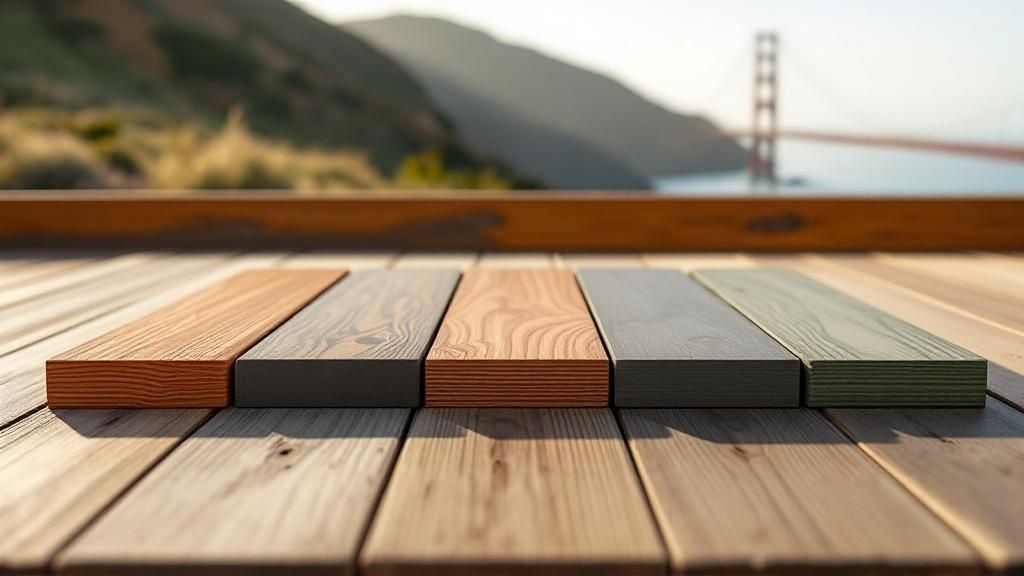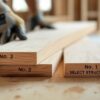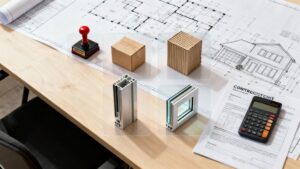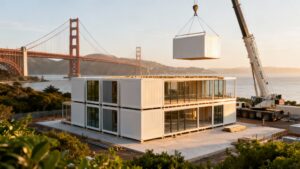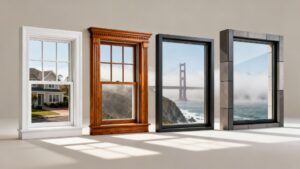Building a deck in the Bay Area isn't just about adding square footage; it's about crafting an outdoor sanctuary that withstands our unique microclimates, from the coastal fog of San Francisco to the sun-drenched hills of Oakland. Selecting the best wood for your deck is the most critical decision in the entire project. It directly influences aesthetics, structural longevity, maintenance requirements, and overall budget.
This guide is built for the professional contractor, architect, and discerning homeowner in the Bay Area who demands specific, actionable intelligence. We move beyond generic advice to provide a comprehensive analysis of top decking materials suited for Northern California. You will find in-depth profiles on leading options such as pressure-treated pine, regional favorites like redwood and cedar, and exotic hardwoods including Ipe.
We will break down the critical performance factors for each material:
- Durability and Weather Resistance: How does it handle Bay Area moisture and sun exposure?
- Maintenance Demands: What is the real-world commitment for cleaning, staining, and sealing?
- Cost Analysis: What are the upfront material costs and long-term value propositions?
- Aesthetics and Design: How does it align with regional architectural styles, from Berkeley craftsman to modern minimalist?
By the end of this roundup, you'll have the clear, practical information needed to confidently select the best wood for a deck that is not only visually stunning but also resilient and perfectly engineered for the Bay Area lifestyle.
1. Pressure-Treated Pine: The Workhorse of Decking
Pressure-treated (PT) pine stands as the most popular and cost-effective material in the decking industry. For contractors, builders, and homeowners across the Bay Area, it represents a practical foundation for countless outdoor projects. It is a softwood, typically Southern Yellow Pine, that has been chemically treated to resist rot, decay, and insect infestation.
The treatment process involves placing lumber in a pressurized tank and forcing chemical preservatives deep into the wood's cellular structure. This makes it exceptionally durable for outdoor applications. Its widespread availability and affordability make it the go-to choice for everything from residential decks in the East Bay to community park boardwalks.
Performance and Practical Applications
Pressure-treated pine is a versatile material that balances cost and performance effectively, making it the best wood for a deck when budget is the primary driver. Its enhanced durability ensures it can withstand the Bay Area's wet winters and foggy mornings.
- Longevity: With proper maintenance, a PT pine deck can last 15-20 years or more.
- Strength: It has a good strength-to-weight ratio, suitable for all structural components of a deck, including posts, joists, and decking boards.
- Versatility: PT pine can be easily stained or painted to match any architectural style, offering design flexibility that many contractors appreciate.
Key Insight for Bay Area Builders: Due to the preservatives used, freshly installed pressure-treated lumber has a high moisture content. Always account for slight shrinkage as the wood dries over the first few months. Spacing the deck boards with a 1/8-inch gap during installation will ensure proper spacing after the wood acclimates.
Cost vs. Lifespan Analysis
The primary appeal of pressure-treated pine is its exceptional value. It offers robust protection against common outdoor threats at a fraction of the cost of composites or exotic hardwoods, making it an ideal starting point for budget-conscious clients.
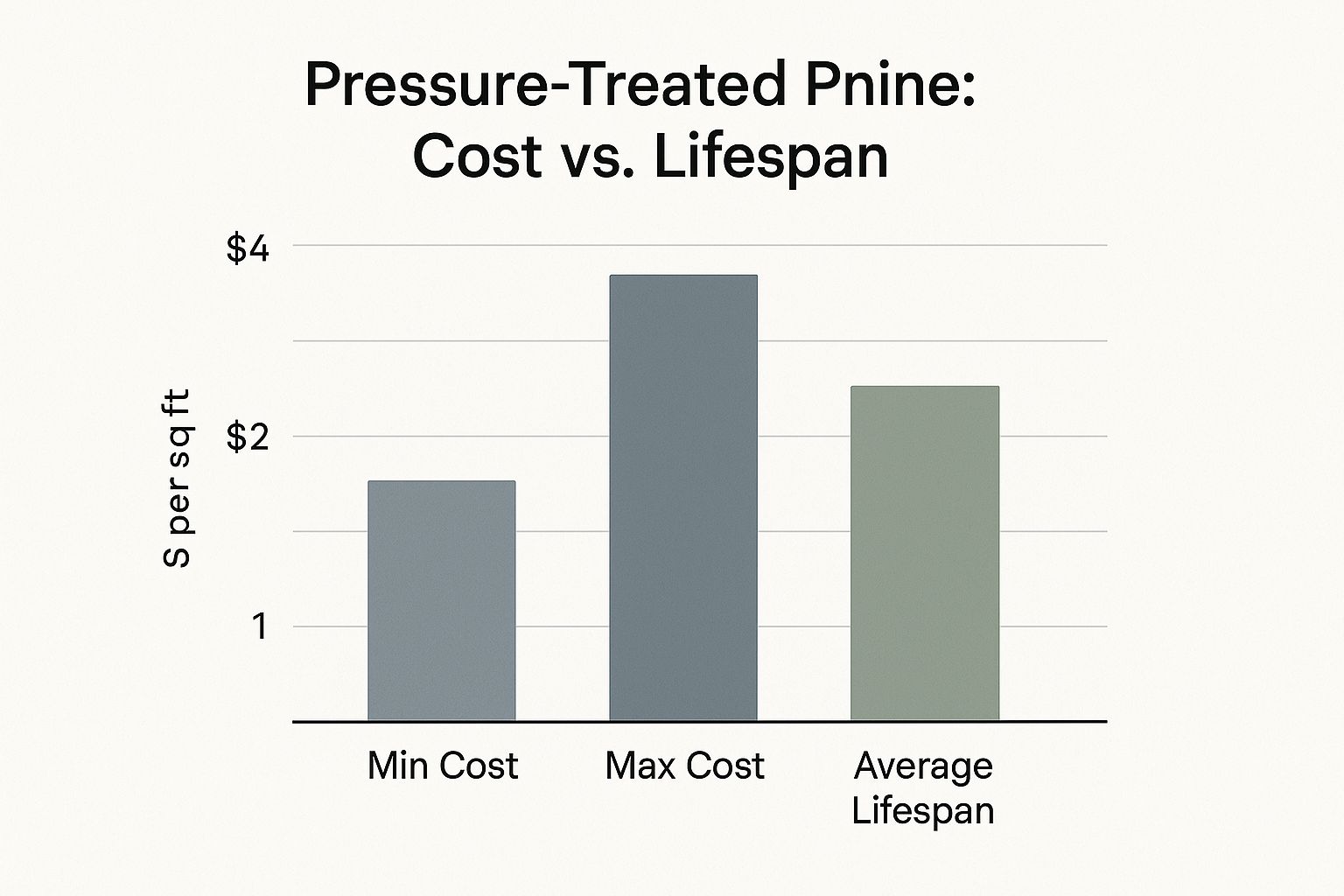
Image Alt Text: Infographic showing the cost and lifespan of a pressure-treated pine deck, highlighting its affordability and durability.
This data illustrates that for a minimal initial investment, pressure-treated pine delivers a respectable service life, solidifying its position as the workhorse of the decking world.
Essential Installation and Maintenance Tips
To maximize the lifespan and appearance of a PT pine deck, follow these essential guidelines:
- Allow for Drying: Wait 3-6 months after installation before applying a high-quality stain or sealant. This allows excess moisture from the treatment process to evaporate, ensuring better finish adhesion.
- Use Correct Fasteners: The chemicals in modern PT wood can corrode standard steel. Always use hot-dip galvanized or stainless steel screws, nails, and connectors to prevent fastener failure and unsightly rust stains.
- Seal Regularly: Plan to clean and reapply a water-repellent sealer every 2-3 years. This vital step protects the wood from moisture absorption and UV degradation, which is crucial for weathering the Bay Area's seasonal climate shifts.
2. Cedar: A Premium Choice for Natural Beauty
Cedar, specifically Western Red Cedar, is a premium softwood renowned for its natural elegance and inherent durability. It is prized by architects, builders, and homeowners for its rich, warm tones and straight grain. Unlike pressure-treated wood, cedar contains natural oils and tannins that make it inherently resistant to rot, decay, and insects without chemical treatment.
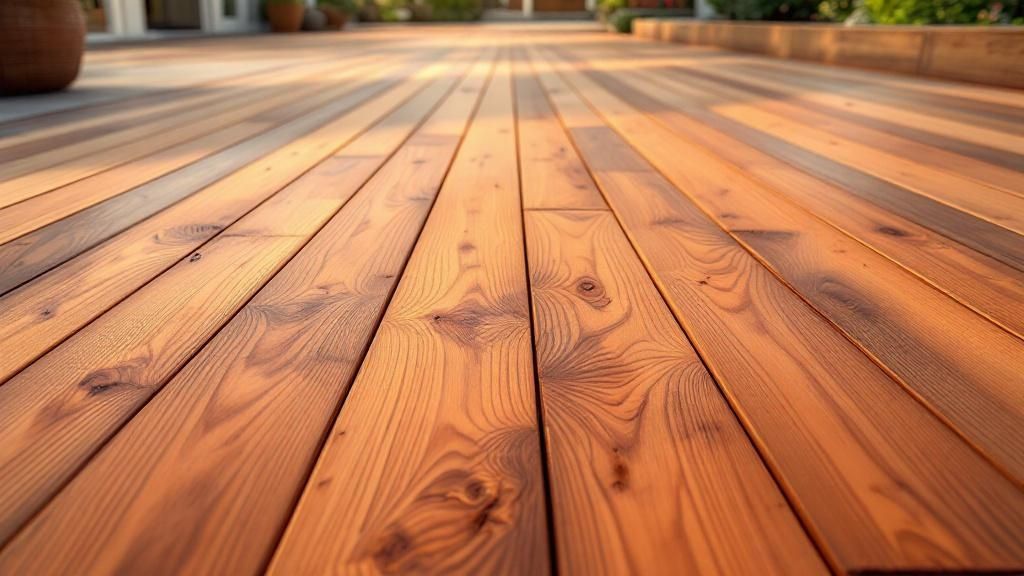
Image Alt Text: A beautiful cedar deck showcasing its warm, reddish-brown tones and natural grain, complementing a modern home.
This natural resilience makes it a top-tier choice for high-end residential projects across the Bay Area, from the coastal homes of Marin County to the sophisticated backyards of Berkeley. Its dimensional stability means it is less prone to warping or twisting than other softwoods. This combination of aesthetics and performance solidifies cedar as a contender for the best wood for a deck when appearance and natural resistance are priorities.
Performance and Practical Applications
Cedar offers a superior aesthetic that complements a wide range of Bay Area architectural styles, from modern minimalist designs to rustic retreats. Its lightweight yet durable nature makes it easy for contractors to work with on-site.
- Longevity: A well-maintained cedar deck can last 20-30 years, often outliving pressure-treated alternatives.
- Aesthetics: Cedar’s natural reddish-brown hues provide a high-end finish. It can be left to weather to a beautiful silvery-gray or stained to preserve its original color.
- Workability: It is easy to cut, sand, and shape, allowing for intricate designs. However, it is a softer wood, so care must be taken to avoid dents during construction.
Key Insight for Bay Area Builders: Cedar's natural oils provide excellent weather resistance, but they don't fully protect against UV degradation. To prevent the wood from fading to a silver-gray (unless desired), recommend a high-quality, UV-blocking, oil-based stain. This is especially important for decks with significant sun exposure in areas like Oakland or Walnut Creek.
Cost vs. Lifespan Analysis
Cedar represents a significant step up in cost from pressure-treated pine, but it justifies the investment with a longer lifespan and unparalleled natural beauty. It occupies a middle ground in pricing, making it more accessible than exotic hardwoods like Ipe.
For projects where the deck is a central feature of the home's design, such as a modern cedar addition or a Japanese-style garden, the visual impact of cedar is well worth the premium. Its longevity also means a lower lifetime cost compared to cheaper materials that may need replacing sooner.
Essential Installation and Maintenance Tips
Proper installation and maintenance are key to unlocking cedar's full potential and ensuring its longevity.
- Pre-Drill Fastener Holes: To prevent the wood from splitting, especially near the ends of boards, always pre-drill pilot holes for screws.
- Use Correct Fasteners: Like with PT wood, standard fasteners will react with cedar’s natural tannins, causing black stains. Always use stainless steel or high-quality, hot-dip galvanized fasteners to ensure a clean, lasting finish.
- Annual Cleaning: Gently clean the deck each year with a mild detergent and a soft-bristle brush to remove dirt and mildew, preserving the wood's natural beauty.
3. Redwood: The Bay Area’s Iconic Decking Wood
California Redwood is a premium decking material celebrated for its stunning natural beauty and impressive durability. Harvested from some of the world's most majestic trees, redwood's rich, warm color and straight grain make it a top choice for high-end projects where aesthetics are paramount. Its natural tannins act as a built-in preservative, providing exceptional weather resistance without chemical treatments.
This iconic West Coast wood is synonymous with luxury and performance, making it a local favorite for builders in Berkeley, Oakland, and across Northern California. Its unique cellular structure contains little to no pitch or resins, which allows it to absorb and retain finishes exceptionally well. For architects and builders, redwood offers an unmatched combination of elegance and longevity.
Performance and Practical Applications
Redwood’s natural stability and resistance to warping make it a superior choice for decking boards, railings, and custom features. It stands as a top contender for the best wood for a deck when visual impact and natural performance are the highest priorities. Its ability to withstand the Bay Area’s microclimates, from coastal fog to inland heat, is a key advantage.
- Longevity: A well-maintained redwood deck can easily last 20-30 years or more, developing a distinguished patina over time.
- Strength: While lightweight, redwood offers excellent dimensional stability and strength, making it suitable for both decking surfaces and intricate design elements.
- Sustainability: When sourced from managed forests, redwood is a sustainable choice. Organizations like the California Redwood Association promote responsible forestry practices.
Key Insight for Bay Area Builders: Redwood's color can vary significantly based on its grade. For a consistent, rich red appearance, specify "all-heart" grades. Be aware that it will naturally weather to a soft, silvery gray if left unstained, a look that many designers intentionally seek for modern or rustic projects.
Cost vs. Lifespan Analysis
Redwood represents a significant investment upfront, costing more than pressure-treated softwoods but often less than exotic hardwoods like Ipe. However, its extended lifespan and timeless appeal provide substantial long-term value. This makes it a preferred material for historic home restorations and high-end new construction where initial cost is secondary to lasting quality. You can find more details about selecting the right Redwood products at Truitt & White.
Essential Installation and Maintenance Tips
To preserve the beauty and structural integrity of a redwood deck, proper installation and care are crucial.
- Use Correct Fasteners: The tannins in redwood can react with galvanized fasteners, causing black stains. Always use high-quality stainless steel screws and connectors to ensure a clean, blemish-free finish.
- Allow for Acclimation: It's good practice to let redwood boards acclimate on-site for several days before installation. This allows the wood's moisture content to equalize with the local environment, minimizing movement post-installation.
- Apply UV Protection: To maintain redwood's vibrant color, apply a high-quality, UV-inhibiting sealer or stain shortly after installation. Plan to clean and reapply the finish every 1-3 years, depending on the deck's exposure to sun and rain.
4. Ipe (Brazilian Walnut): The Gold Standard of Hardwood Decking
Ipe, often called Brazilian Walnut, is a dense tropical hardwood from South America renowned for its exceptional durability and natural beauty. For high-end residential projects and demanding commercial applications, Ipe is widely considered the best wood for a deck when performance and longevity are paramount. Its incredible density gives it a Class A fire rating—the same as concrete and steel—and makes it naturally resistant to rot, decay, and insect attacks.
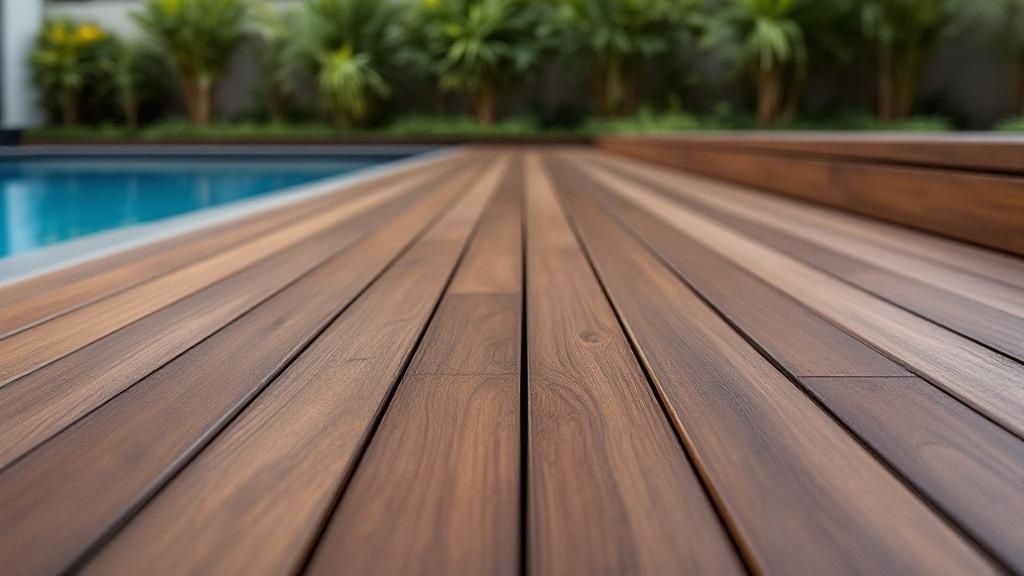
Image Alt Text: Close-up of Ipe (Brazilian Walnut) decking showcasing its rich, dark color and dense grain structure.
The wood features a distinctive chocolate-brown color with fine graining. This premium material is a favorite among luxury resort developers and high-end deck contractors who require a surface that will maintain its structural integrity and elegant appearance for decades with minimal intervention.
Performance and Practical Applications
Ipe delivers unparalleled performance, setting the industry benchmark for hardwood decking. Its extreme hardness and natural oils provide a powerful defense against the elements, making it suitable for even the most challenging Bay Area commercial waterfront projects.
- Longevity: An Ipe deck can easily last 50+ years, and some installations have been known to last over 75 years, even without preservatives.
- Strength: As one of the hardest woods in the world, Ipe is incredibly resistant to scratches, dents, and heavy wear, making it ideal for high-traffic areas.
- Fire Resistance: Ipe's Class A fire rating is a significant benefit in fire-prone regions of California, providing an extra layer of safety.
Key Insight for Bay Area Builders: Due to its extreme density, Ipe is challenging to work with. Always use carbide-tipped saw blades and pre-drill every hole for fasteners. Attempting to drive screws or nails directly will result in split boards and broken fasteners.
Cost vs. Lifespan Analysis
Ipe represents a significant upfront investment, often costing three to five times more than pressure-treated pine. However, its phenomenal lifespan and low maintenance needs provide exceptional long-term value. For clients with a "do it once, do it right" philosophy, Ipe is the clear choice. Learn more about the best hardwood decking options on truittandwhite.com.
Essential Installation and Maintenance Tips
Proper installation is critical to unlocking the full potential of an Ipe deck. Its unique properties demand specific techniques and materials.
- Acclimate the Wood: Allow Ipe boards to acclimate on-site for at least one to two weeks before installation. This lets the wood adjust to the local humidity and temperature.
- Use Correct Fasteners: The natural tannins and density of Ipe require high-quality fasteners. Always use 305 or 316-grade stainless steel screws to prevent corrosion and black staining.
- Maintain or Let Weather: To maintain the rich brown color, clean the deck and apply a UV-protecting hardwood oil annually. If a low-maintenance approach is preferred, let the wood weather naturally to a beautiful silver-gray patina without compromising its structural integrity.
5. Composite Decking: The Low-Maintenance Innovator
Composite decking represents a significant technological leap in outdoor living materials, offering a high-performance alternative to traditional wood. It is an engineered product manufactured from a blend of recycled wood fibers and plastic polymers. This combination creates a durable, dense board that mimics the appearance of natural wood without its vulnerabilities to rot, decay, and insects.
This material has become a favorite for projects where longevity and minimal upkeep are paramount. From family decks in Berkeley to commercial restaurant patios in Oakland, composite decking provides a consistent, reliable surface. The industry, pioneered by brands like Trex and TimberTech, offers a vast array of colors and textures to satisfy both modern and traditional design aesthetics.
Performance and Practical Applications
Composite decking is engineered for superior endurance, making it a strong contender when long-term performance and low maintenance are the highest priorities. Its composition makes it exceptionally resistant to the moisture and temperature fluctuations common in the Bay Area, preventing warping, splitting, and splintering.
- Longevity: Most composite decking comes with a 25-50 year limited warranty from manufacturers like Trex or TimberTech, often outlasting even the most durable hardwoods.
- Maintenance: Composites never need sanding, staining, or sealing. A simple cleaning with soap and water is all that is required to maintain their appearance.
- Aesthetics: Modern composites offer multi-tonal colors and deep, embossed grain patterns that provide a realistic wood look with fade and stain resistance.
Key Insight for Bay Area Builders: Composite decking experiences thermal expansion and contraction. Always follow the manufacturer's specific guidelines for gapping, both side-to-side and at butt joints, to accommodate this movement. Failure to do so can lead to buckling during hot summer afternoons.
Cost vs. Lifespan Analysis
While composite decking has a higher initial investment compared to pressure-treated woods, its value proposition becomes clear over its lifespan. The total cost of ownership is significantly lower due to the near-elimination of ongoing maintenance expenses. This makes it a smart investment for clients who prioritize a hassle-free outdoor space. You can explore more options in our comprehensive deck planning guide and materials to compare composites with other decking choices.
Essential Installation and Maintenance Tips
Proper installation is key to unlocking the full performance potential of composite decking.
- Follow Manufacturer Specs: Each brand has unique requirements. Always use the manufacturer-specified hidden fasteners or color-matched screws for a clean finish and to ensure warranty compliance.
- Ensure Proper Ventilation: A deck built with composites requires adequate airflow underneath to prevent moisture buildup. Maintain a minimum ground clearance as recommended by the manufacturer.
- Gentle Cleaning: Clean your composite deck at least once a year with soap, water, and a soft-bristle brush. Avoid using pressure washers with high PSI settings, as this can damage the surface.
6. Teak: A Top-Tier Choice for Luxury and Performance
Teak is a premium tropical hardwood celebrated worldwide for its unparalleled beauty, durability, and natural resistance to the elements. Originally the material of choice for shipbuilding and luxury yacht decking, its legendary performance has made it a symbol of high-end outdoor living. For discerning clients and prestige projects, teak offers an unmatched combination of elegance and longevity.
Sourced from the Tectona grandis tree, teak contains a high concentration of natural oils and silica. These compounds act as a powerful built-in defense mechanism, repelling water, resisting rot, and deterring insects without any chemical treatment. This makes it ideal for demanding environments, from high-end residential decks in the Berkeley Hills to upscale resort pool areas.
Performance and Practical Applications
Teak’s exceptional stability and weather-resistant properties make it the best wood for a deck when performance and luxury are the top priorities. Its dense grain and golden-honey hue create a stunningly sophisticated surface that ages gracefully. For a deeper dive, read about its properties that make teak a preferred choice for marine applications.
- Longevity: A teak deck can last 40-75 years or even longer with minimal maintenance, far outperforming most other wood species.
- Stability: Teak has very low shrinkage rates, meaning it resists warping, twisting, and checking even when exposed to the Bay Area's fluctuating moisture levels.
- Low Maintenance: Teak does not require sealants or preservatives to maintain its structural integrity. It can be left to weather naturally to an elegant silver-gray patina.
Key Insight for Bay Area Builders: When specifying teak, always verify the source. True, old-growth teak is rare and expensive. For modern projects, look for FLEGT-licensed or FSC-certified plantation teak to ensure responsible sourcing and consistent quality for your clients in the Bay Area.
Cost vs. Lifespan Analysis
Teak represents a significant upfront investment, often costing several times more than domestic hardwoods. However, its extraordinary lifespan and minimal maintenance requirements create a value proposition centered on long-term performance and enduring beauty.
For projects where the budget can accommodate it, teak delivers a return on investment through its decades-long service life and the timeless prestige it adds to a property. It is the definitive choice for clients who demand the absolute best.
Essential Installation and Maintenance Tips
Proper installation and care are crucial for preserving the integrity and appearance of a premium teak deck.
- Use Correct Fasteners: Teak's natural oils can interact with certain metals. Only use high-grade 316 stainless steel or bronze fasteners to prevent corrosion and black staining.
- Pre-Drill Holes: Teak is an extremely dense hardwood. Always pre-drill pilot holes for screws to prevent the wood from splitting and to ensure a clean, professional finish.
- Manage Color: To maintain its original golden-brown color, clean the deck annually and apply a specialized teak sealer. If a natural, low-maintenance look is preferred, simply allow it to weather to its signature silver-gray.
7. Mahogany: A Classic for Timeless Elegance
Genuine mahogany is a premium hardwood celebrated for its luxurious appearance, exceptional workability, and impressive natural durability. Prized for its rich, consistent reddish-brown hue that deepens over time, mahogany offers a sophisticated and timeless aesthetic. Often sourced from certified sustainable plantations, it provides a responsible alternative to other tropical hardwoods, making it a top choice for luxury residential decks and historic restorations throughout the Bay Area.
Its straight, fine grain and interlocking patterns create a stunningly beautiful surface that is largely free of knots and voids. This visual appeal, combined with its inherent resistance to rot and insects, has made it a benchmark material. For contractors and architects aiming to deliver a project with undeniable class and proven performance, mahogany is an excellent selection.
Performance and Practical Applications
Mahogany delivers a powerful combination of beauty and brawn, making it a contender for the best wood for a deck when aesthetics and long-term value are paramount. Its dimensional stability means it is less prone to warping or twisting, a key benefit in the fluctuating humidity of the Bay Area's microclimates.
- Longevity: A well-maintained mahogany deck can easily last 25 years or more, developing a graceful, silvery patina if left untreated.
- Workability: Despite its density, mahogany is surprisingly easy to cut, sand, and machine, which is highly valued by builders and artisans.
- Stability: It holds finishes exceptionally well and is dimensionally stable, ensuring tight joinery and a clean, uniform appearance for years.
Key Insight for Bay Area Builders: To prevent splitting, especially near board ends, always pre-drill pilot holes for your fasteners. Given mahogany's value, this small step is crucial for achieving a flawless installation and preventing material waste on high-end projects from Berkeley to San Francisco.
Cost vs. Lifespan Analysis
Mahogany sits in the upper-mid to premium price range, costing more than domestic softwoods like redwood or cedar but generally less than Ipe. Its price reflects its quality, durability, and the costs associated with sustainable harvesting. For clients who desire a classic, high-end look without venturing into the most expensive exotic options, mahogany offers a perfect balance.
The initial investment is offset by its long service life and the elevated aesthetic it brings to a property. This makes it a popular choice for custom home builders and renovation specialists looking to add significant and lasting value.
Essential Installation and Maintenance Tips
Proper installation and care are vital to preserving the rich beauty and integrity of a mahogany deck.
- Source Sustainably: Insist on mahogany with certifications like those from the Forest Stewardship Council (FSC) to ensure it comes from responsibly managed forests.
- Use Proper Fasteners: Like other dense hardwoods, mahogany requires high-quality fasteners. Use marine-grade stainless steel screws to prevent corrosion and unsightly black staining.
- Protect its Color: To maintain the deep reddish-brown color, apply a high-quality, UV-protective oil or finish annually. This is essential for protecting the wood from the Bay Area's intense sun and preventing it from weathering to a silver-gray.
8. Pressure-Treated Hardwood (Eucalyptus): The Sustainable Performer
Pressure-treated eucalyptus emerges as a compelling mid-tier option, bridging the gap between common softwoods and premium exotic hardwoods. This fast-growing hardwood is chemically treated to significantly boost its inherent durability, offering a sustainable and high-performance decking solution. For builders and homeowners in the Bay Area, it delivers enhanced strength and rot resistance at a more accessible price point than tropical hardwoods.
Sourced from sustainably managed forests, eucalyptus combines ecological responsibility with robust physical properties. The pressure-treatment process infuses the wood with preservatives that protect against decay and insects. This makes it a reliable choice for eco-conscious residential decks and mid-range projects where both performance and environmental impact are key considerations.
Performance and Practical Applications
Treated eucalyptus provides a significant upgrade in hardness and density over pressure-treated pine, making it the best wood for a deck when seeking a balance of durability, sustainability, and value. Its resilience makes it well-suited to handle the variable Bay Area climate, from damp, foggy mornings in San Francisco to the hot, dry summers of the East Bay.
- Longevity: Properly maintained, a pressure-treated eucalyptus deck can last 20-25 years, rivaling the lifespan of more expensive materials.
- Strength: As a hardwood, it offers superior resistance to dents, scratches, and daily wear-and-tear compared to softwoods.
- Sustainability: Sourced from rapidly renewable forests, it presents a greener alternative to slow-growth woods. Understanding how to calculate a product's carbon footprint can be valuable for builders comparing materials.
Key Insight for Bay Area Builders: Treated eucalyptus is denser than pine, which affects installation. Always pre-drill pilot holes for fasteners, especially near board ends, to prevent splitting and ensure a clean, professional finish. Using high-quality, hardwood-rated deck screws is essential.
Cost vs. Lifespan Analysis
Pressure-treated eucalyptus occupies a smart middle ground in the market. It costs more than standard PT pine but remains significantly more affordable than Ipe. This positions it as an excellent value proposition for clients who want premium performance without the premium price tag.
Its longer expected lifespan and lower maintenance needs compared to softwoods can lead to a lower total cost of ownership. For more information on sustainable building materials, you can learn more about sustainable innovations at Truitt & White.
Essential Installation and Maintenance Tips
To ensure your treated eucalyptus deck performs optimally, adhere to these key practices:
- Acclimate Before Finishing: Allow the deck to weather for 3-6 months before applying a finish. This lets the wood stabilize and ensures better penetration of hardwood-specific stains or oils.
- Use Proper Fasteners: The density of eucalyptus and the chemicals used in treatment require robust fasteners. Always use high-quality stainless steel screws designed for hardwoods to prevent corrosion.
- Apply Hardwood-Specific Finishes: Use a penetrating oil or a finish specifically formulated for hardwoods. These products provide superior protection against UV rays and moisture, which is vital for preserving its color and integrity.
- Perform Regular Cleaning: Keep the deck surface free of debris to prevent moisture buildup and mildew growth. A simple cleaning once or twice a year will keep it in excellent condition.
Top 8 Deck Wood Options Comparison
| Material | Implementation Complexity 🔄 | Resource Requirements ⚡ | Expected Outcomes 📊 | Ideal Use Cases 💡 | Key Advantages ⭐ |
|---|---|---|---|---|---|
| Pressure-Treated Pine | Low – easy to cut and install | Low – widely available, affordable | Durable with maintenance, 15-20 years lifespan | Entry-level DIY decks, community parks | Most affordable, easy to work, good warranty |
| Cedar | Moderate – pre-drilling recommended | Moderate – higher cost, limited regions | Naturally weather-resistant, 15-25 years | High-end residential, Japanese-style gardens | No chemicals, beautiful grain, lightweight |
| Redwood | Moderate – requires careful sourcing | Moderate to high – expensive and limited supply | Superior durability, 20-30 years lifespan | Luxury coastal homes, historic restorations | Superior natural durability, fire-resistant |
| Ipe (Brazilian Walnut) | High – special tools needed | High – very expensive, heavy material | Exceptional durability, 25-40 years lifespan | Luxury condos, commercial waterfronts | Extremely durable, scratch resistant |
| Composite Decking | Low – straightforward installation | Moderate to high – higher upfront cost | Low maintenance, consistent appearance, 25-30 years | High-traffic areas, low-maintenance homes | Minimal upkeep, rot and splinter resistant |
| Teak | High – specialized installation | Very high – expensive and limited sources | Superior weather resistance, 30-50 years lifespan | Luxury yachts, high-end resorts | Naturally oily, durable, non-slip |
| Mahogany | Moderate – pre-drilling recommended | High – expensive and limited availability | Durable, 20-30 years lifespan | Historic restorations, luxury decks | Beautiful color, good workability |
| Pressure-Treated Hardwood (Eucalyptus) | Moderate – requires pre-drilling | Moderate – sustainable and affordable | Good durability, 15-25 years lifespan | Eco-friendly projects, mid-range decks | Sustainable, hardwood strength |
Frequently Asked Questions About Decking Wood
1. What is the most durable wood for a deck in the Bay Area climate?
Ipe is widely considered the most durable decking wood due to its incredible density and natural resistance to rot, insects, and moisture. For projects in the foggy, damp conditions of San Francisco or the hot, sunny East Bay, Ipe provides unparalleled longevity, often lasting over 50 years with minimal maintenance.
2. Which decking material requires the least maintenance?
Composite decking is the lowest-maintenance option available. Unlike wood, it never needs sanding, staining, or sealing to protect it from the elements. A simple annual cleaning with soap and water is all that's required to keep it looking great, making it a popular choice for busy homeowners.
3. Are redwood and cedar good choices for Bay Area decks?
Yes, both redwood and cedar are excellent choices and are regional favorites for their natural beauty and inherent resistance to decay. Redwood is particularly iconic to California and performs very well. Both options will weather to a beautiful silver-gray if left unstained, a look that suits many architectural styles in Berkeley and Oakland.
4. How much more does a composite deck cost than a pressure-treated pine deck?
Initially, composite decking can cost 2-3 times more than pressure-treated pine for the materials alone. However, the total cost of ownership is often lower for composites over the deck's lifespan. This is because you save significantly on the recurring costs of stains, sealers, and labor required to maintain a wood deck every few years.
5. Why do I need to use stainless steel screws with woods like Ipe and Redwood?
Woods like Ipe, Redwood, and Cedar contain natural tannins and oils that cause a chemical reaction with standard galvanized steel, resulting in black streaks and corrosion. Using high-quality stainless steel fasteners is essential to prevent these unsightly stains and ensure the long-term structural integrity of your deck.
Build Your Perfect Bay Area Deck with Truitt & White
Navigating the world of decking materials can feel overwhelming, but the "best wood for deck" is a choice that balances aesthetics, budget, and performance. From the workhorse reliability of pressure-treated pine to the luxury of Ipe, each option presents a unique pathway to creating a stunning and functional outdoor living space.
The decision ultimately hinges on aligning your project's specific needs with the inherent characteristics of the wood. A clear understanding of these trade-offs is the cornerstone of a successful build, ensuring the final structure not only meets but exceeds expectations for years to come.
Recapping Your Decking Choices: Key Takeaways
Let's distill the essential insights from our detailed comparison to help guide your final decision:
- For Budget-Conscious Durability: Pressure-treated pine and pressure-treated hardwoods like eucalyptus offer the most accessible price points. While they require diligent maintenance, their proven performance makes them a practical choice for many Bay Area projects.
- For Natural Beauty and Regional Charm: California Redwood and Western Red Cedar are iconic choices that blend seamlessly with our local landscapes. They offer excellent natural resistance to rot and insects.
- For Unmatched Longevity and Low Maintenance: Tropical hardwoods like Ipe and Teak represent the pinnacle of performance. Their incredible density provides a nearly indestructible surface, making them a wise long-term investment.
- For High-Tech Performance and Minimal Upkeep: Composite decking has redefined the market by engineering out the natural weaknesses of wood. It provides a consistent, splinter-free surface that never needs staining or sealing.
- For a Touch of Elegance: Mahogany offers a beautiful middle ground, providing a rich, luxurious appearance with good durability at a more moderate price point than top-tier tropicals.
From Blueprint to Reality: Your Actionable Next Steps
With this knowledge in hand, the path forward becomes clearer. Your next step is to translate these insights into a concrete plan for your specific project.
- Define Your Priorities: Revisit your initial goals. Is cost the primary driver? Is low maintenance non-negotiable? Or is the aesthetic allure of a specific wood grain the most critical factor? Rank these priorities to narrow down your top material choices.
- Calculate Your Realistic Budget: Move beyond material cost per linear foot. Factor in the total cost of ownership, including fasteners, finishing products, and potential labor costs for installation and long-term maintenance.
- Assess Your Site-Specific Conditions: Consider the microclimate of your property. Is the deck in full, harsh sun, which might favor a more stable hardwood or a capped composite? Is it in a damp, shady area where rot resistance is paramount?
Pro-Tip: Always obtain physical samples. The look and feel of decking materials can vary significantly from online photos. Handling a sample of Redwood versus Ipe clarifies the difference in density, grain, and color, helping you make a more confident and informed choice.
Choosing the best wood for your deck is a critical decision, but you don’t have to make it alone. For nearly 80 years, Truitt & White has been the Bay Area's trusted partner, supplying the highest quality lumber, decking, and building materials to contractors, architects, and homeowners. Our expert team at our Berkeley lumberyard is ready to provide the personalized advice and premium products you need to build with confidence.
Visit our Berkeley showroom or contact us today to get started on your project.


